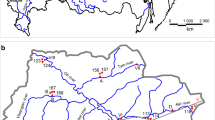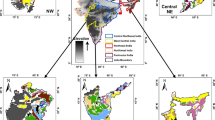Abstract
Changes in rainfall and temperature patterns can impact water security, mainly in tropical and subtropical regions. This study aimed to assess if climate change in Minas Gerais state, Brazil has impacted groundwater storage. Headwaters of four representative basins with minimum land use change were selected to quantify the effects of atmospheric forcing. Daily streamflow time series were used to assess changes in groundwater storage using the Brutsaert method. The Mann–Kendall and Sen tests were applied to evaluate the trends and determine the rate of change. Most studied sub-basins showed an upward trend in temperature and evapotranspiration, while a nonsignificant trend was found for annual precipitation in some sub-basins. Mean annual streamflow, minimum streamflow over seven consecutive days (Q7, min), and groundwater storage (S) showed downward trends in most sub-basins. The Jequitinhonha sub-basin is the closest hydrological unit to the pristine conditions, indicating that changes in climate have impacted its hydrological response. In contrast, at the Piracicaba sub-basin and Sapucaí sub-basin, it was not clear that climate changes can exclusively explain the decreasing trend in groundwater storage due to the changes in land use from native forest (Atlantic Forest and Cerrado) to pasture. The São Francisco and Grande River sub-basins are the most anthropized and showed the lowest reduction rates, showing that these sub-basins have a relevant resilience to climate change as their geomorphological aspects, i.e., soils, topography, soil-vegetation relationship, and hydrogeology, play a fundamental role in buffering the hydrological impacts. Our results can contribute to water resource management in Minas Gerais state, supporting decision-makers actions to minimize the effects.







Similar content being viewed by others
Data availability
The datasets analyzed in this study are available in https://bdmep.inmet.gov.br/# and https://www.snirh.gov.br/hidroweb.
References
Alley WM, Healy RW, LaBaugh JW, Reilly TE (2002) Flow and storage in groundwater systems. Science 296(5575):1985–1990
Ávila LF, Mello CR, Yanagi SNM, Neto OBS (2014) Tendências de temperaturas mínimas e máximas do ar no Estado de Minas Gerais. Pesq Agropec Bras 49:247–256
Brutsaert W (2008) Long-term groundwater storage trends estimated from streamflow records: climatic perspective. Water Resour Res 44:W02409
Brutsaert W (2010) Annual drought flow and groundwater storage trends in the eastern half of the United States during the past two-third century. Theor Appl Climatol 100(1–2):93–523
Brutsaert W, Nieber JL (1977) Regionalized drought flow hydrographs from a mature glaciated plateau. Water Resour Res 13:637–643
Campos JA (2022) Dinâmica da vulnerabilidade ambiental da bacia hidrográfica do Rio Doce como subsídio ao planejamento e gestão de recursos ambientais e hídricos. Dissertation, Universidade Federal de Viçosa, Viçosa (in Portuguese)
Campos JO, Chaves HML (2020) Tendências e Variabilidades nas Séries Históricas de Precipitação Mensal e Anual no Bioma Cerrado no Período 1977–2010. Rev Bras De Meteorol 35:157–169
CETEC, FEAM, UFV, UFLA (2010) Mapa de solos do Estado de Minas Gerais, 1. In: Secretaria do Meio Ambiente e Desenvolvimento Sustentável. Fundação Estadual do Meio Ambiente - FEAM, Belo Horizonte
Cunha ZA, Mello CR, Beskow S, Vargas MM, Guzman JA, Moura MM (2023) A modeling approach for analyzing the hydrological impacts of the agribusiness land-use scenarios in an Amazon basin. Land 12:1422
Gao Z, Zhang L, Cheng L, Zhang X, Cowan T, Cai W, Brutsaert W (2015) Groundwater storage trends in the Loess Plateau of China estimated from streamflow records. J Hydrol 530:281–290
Gouveia RGL, Galvanin EAS, Neves SMAS (2013) Aplicação do indíce de transformação antrópica na análise multitemporal da bacia do córrego do Bezerro Vermelho em Tangará da Serra-MT. Rev Árvore 37:1045–1054
Holman IP (2006) Climate change impacts on ground-water recharge: uncertainty, shortcomings, and the way forward. Hydrogeol J 14:637–647
Huang P, Wang G, Guo L, Mello CR, Li K, Ma J, Sun S (2023) Most global gauging stations present biased estimations of total catchment discharge. Geophys Res Lett 50:e2023GL104253
Jiménez Cisneros BE, Oki T, Arnell NW, Benito G, Cogley JG, Döll P, Jiang T, Mwakalila SS (2014) Freshwater resources. In: Field CB, Barros VR, Dokken DJ, Mach KJ, Mastrandrea MD, Bilir TE, Chatterjee M, Ebi KL, Estrada YO, Genova RC, Girma B, Kissel ES, Levy AN, MacCracken S, Mastrandrea PR, White LL (eds) Climate change 2014: impacts, adaptation, and vulnerability. Part A: global and sectoral aspects. Contribution of working group II to the fifth assessment report of the intergovernmental panel on climate change. Cambridge University Press, Cambridge, United Kingdom and New York, NY, USA, pp 229–269
Jones J, Creed IF, Hatcher KL, Warren RJ, Adams MB, Benson MH, Boose E, Brown WA, Campbell JL, Covich A, Clow DW, Dahm CN, Elder K, Ford CR, Grimm NB, Henshaw DL, Larson KL, Miles ES, Miles KM, Sebestyen SD, Spargo AT, Stone AB, Vose JM, Williams MW (2012) Ecosystem processes and human influences regulate streamflow response to climate change at long-term ecological research sites. Bioscience 62:390–404. https://doi.org/10.1525/bio.2012.62.4.10
Kendall M (1975) Multivariate analysis. Charles Griffin & Company, London
Kormos PR, Luce CH, Wenger SJ, Berghuijs WR (2016) Trends and sensitivities of low streamflow extremes to discharge timing and magnitude in Pacific Northwest mountain streams. Water Resour Res 52(7):4990–5007
Lee S, Ajami H (2023) Comprehensive assessment of baseflow responses to long-term meteorological droughts across the United States. J Hydrol 626:130256
Lémechev T (1982) On hydrological heterogeneity catchment morphology and catchment response. J Hydrol 100:375–375
Lin K, Yeh H (2017) Baseflow recession characterization and groundwater storage trends in northern Taiwan. Hydrol Res 48(6):1745–1756
Liu X, Liu C, Brutsaert W (2020) Mutual consistency of groundwater storage changes derived from GRACE and from baseflow recessions in the Central Yangtze River basin. J Geophys Res Atmos 125:e2019JD031467
Mann HB (1945) Nonparametric tests against trend. Econometrica 13:245–259
Mateo J (1984) Apuntes de Geografia de Los Paisajes. Universitaria, La Habana
Mello CR, Ávila LF, Lin H, Terra MCNS, Chappell NA (2019) Water balance in a neotropical forest catchment of southeastern Brazil. CATENA 173:9–21
Melo LS, Costa V, Fernandes WS (2023) Assessing the anthropogenic and climatic components in runoff changes of the São Francisco river catchment. Water Resour Manag 37:3615–3629
Mendoza GF, Steenhuis TS, Walter MT, Parlange JY (2003) Estimating basin-wide hydraulic parameters of a semi-arid mountainous watershed by recession flow analysis. J Hydrol 279(1–4):57–69
Milliman JD, Farnsworth KL, Jones PD, Xu KH, Smith LC (2008) Climatic and anthropogenic factors affecting river discharge to the global ocean, 1951–2000. Glob Planet Chang 62:187–194
Mutzner R, Bertuzzo E, Tarolli P, Weijs SV, Nicotina L, Ceola S, Tomasic N, Rodriguez-Iturbe I, Parlange MB, Rinaldo A (2013) Geomorphic signatures on Brutsaert base flow recession analysis. Water Resour Res 49:5462–5472
Oliveira PHF, Vieira FR, Christofaro C, Rocha WW, Silva AC (2021) Alterações no regime de vazão e precipitação em trecho da Bacia do Rio Araçuaí, Minas Gerais: caminhamos para a escassez hídrica? Rev Espinhaço. https://doi.org/10.5281/zenodo.5502194
Pereira LC, Balbinot L, Nnadi EO, Mosleh MH, Tonello KC (2022) Effects of Cerrado restoration on seasonal soil hydrological properties and insights on impacts of deforestation and climate change scenarios. Front for Glob Chang 5:882551. https://doi.org/10.3389/ffgc.2022.882551
Pinto LC, Mello CR, Norton LD, Owens PR, Curi N (2016) Spatial prediction of soil-water transmissivity based on fuzzy logic in a Brazilian headwater watershed. CATENA 143:26–34
Regoto P, Dereczynski C, Chou SC, Bazzanela AC (2021) Observed changes in air temperature and precipitation extremes over Brazil. Int J Climatol 41:5125–5142
Sánchez-Murillo R, Brooks ES, Elliot WJ (2015) Baseflow recession analysis in the inland Pacific Northwest of the United States. Hydrogeol J 23:287–303
Sen PK (1968) Estimates of the regression coefficient based on Kendall’s tau. J Am Stat Assoc 63:1379–1389
Silva VO, Mello CR (2020) Meteorological droughts in part of southeastern Brazil: understanding the last 100 years. An Acad Bras Cienc 93:e20201130. https://doi.org/10.1590/0001-3765202120201130
Silva VO, Mello CR, Chou SC (2022) Projections of severe droughts in future climate in Southeast Brazil: a case study in Southern Minas Gerais State, Brazil. Theor Appl Climatol 148:1289–1302
Souza SA, Reis DS Jr (2022) Trend detection in annual streamflow extremes in Brazil. Water 14:1805
Tomasella J, Vieira RMS, Barbosa AA, Rodriguez DA, Santana MO, Sestini MF (2018) Desertification trends in the Northeast of Brazil over the period 2000–2016. Int J Appl Earth Obs Geoinf 73:197–206
Viola MR, Mello CR, Chou SC, Yanagi SN, Gomes JL (2015) Assessing climate change impacts on Upper Grande River Basin hydrology, Southeast Brazil. Int J Climatol 35:1054–1068
Vishwakarma BD, Bates P, Sneeuw N, Westaway RM, Bamber JL (2021) Re-assessing global water storage trends from GRACE time series. Environ Res Lett 16:034005
Warku F, Korme T, Wedajo G, Nedow D (2022) Impacts of land use/cover change and climate variability on groundwater recharge for upper Gibe watershed, Ethiopia. Sustain Water Resour Manag 8(2):3–16
Wendland E, Gomes LH, Troeger U (2015) Recharge contribution to the Guarani aquifer system estimated from the water balance method in a representative watershed. An Acad Bras Cienc 87:595–609
Xiang L, Wang H, Steffen H, Wu P, Jia L, Jiang L, Shen Q (2016) Groundwater storage 693 changes in the Tibetan Plateau and adjacent areas revealed from GRACE satellite gravity 694 data. Earth Planet Sci Lett 449:228–239
Zhang L, Brutsaert W, Crosbie R, Potter N (2014) Long-term annual groundwater storage trends in Australian catchments. Adv Water Resour 74:156–165
Zhu R, Zheng H, Croke B, Jakeman A (2020) Quantifying climate contributions to changes in groundwater discharge for headwater catchments in a major Australian basin. Sci Total Environ 729:138910
Acknowledgements
We thank FAPEMIG and CNPq (number 401156/2022-2) for the scholarships of the first and second authors, respectively.
Funding
Author CR.M.. has received research support from CNPq (Conselho Nacional de Desenvolvimento Científico e Tecnológico, 401156/2022–2).
Author information
Authors and Affiliations
Contributions
All authors contributed to the study's conception and design. Material preparation, data collection, and analysis were performed by Camila Lucia Cardoso Ribeiro and Carlos Rogério de Mello. The first draft of the manuscript was written by Carlos Rogério de Mello and Jorge Alberto Guzman. All authors read and approved the final manuscript.”
Corresponding author
Ethics declarations
Conflict of interest
The authors have no relevant financial or non-financial interests to disclose.
Additional information
Publisher's Note
Springer Nature remains neutral with regard to jurisdictional claims in published maps and institutional affiliations.
Supplementary Information
Below is the link to the electronic supplementary material.
Rights and permissions
Springer Nature or its licensor (e.g. a society or other partner) holds exclusive rights to this article under a publishing agreement with the author(s) or other rightsholder(s); author self-archiving of the accepted manuscript version of this article is solely governed by the terms of such publishing agreement and applicable law.
About this article
Cite this article
Ribeiro, C.L.C., de Mello, C.R. & Guzman, J.A. Groundwater storage trend in headwater basins: shreds of evidence from the last decades in Minas Gerais state, Brazil. Environ Earth Sci 83, 327 (2024). https://doi.org/10.1007/s12665-024-11645-8
Received:
Accepted:
Published:
DOI: https://doi.org/10.1007/s12665-024-11645-8




